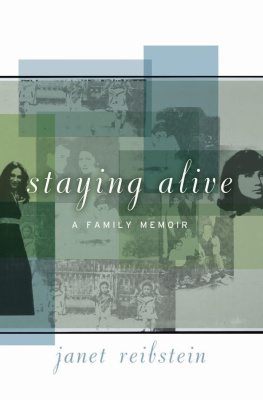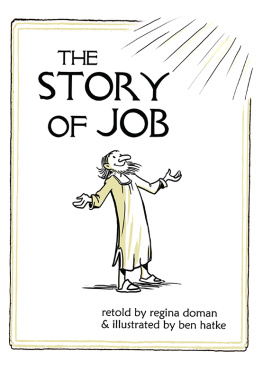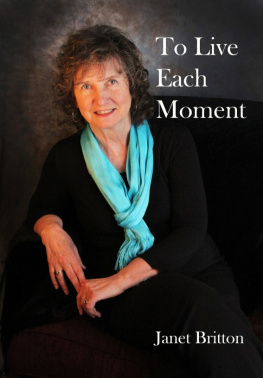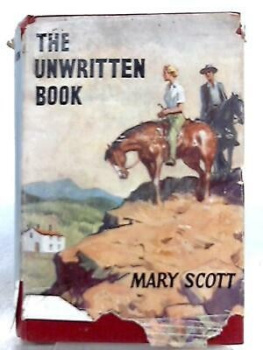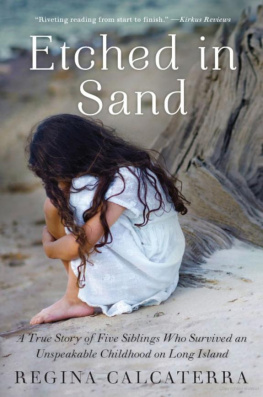STAYING ALIVE
BY THE SAME AUTHOR
The Family Through Divorce: How You Can Limit
the Damage
Love Life: Making Your Relationship Work
Sexual Arrangements: Marriage, Monogamy and Affairs
STAYING
ALIVE
A FAMILY MEMOIR
Janet Reibstein
BLOOMSBURY
Copyright 2002 by Janet Reibstein
Lyric excerpts of 'Bali Ha'i' and 'Happy Talk'
by Richard Rodgers and Oscar Hammerstein II
Copyright 1949 by Richard Rodgers and Oscar Hammerstein II
Copyright Renewed. WILLIAMSON MUSIC owner of publication and allied rights throughout the world. International Copyright Secured.
Reprinted by Permission. All Rights Reserved.
All rights reserved. No part of this book may be used or reproduced in any manner whatsoever without written permission from the Publisher except in the case of brief quotations embodied in critical articles or reviews. For information address
Bloomsbury, 175 Fifth Avenue, New York, N.Y. 10010
Published by Bloomsbury, New York and London
Distributed to the trade by Holtzbrinck Publishers
eISBN: 978-1-59691-891-7
First published in the United States by Bloomsbury in 2002
This paperback edition published in 2003
1 3 5 7 9 10 8 6 4 2
Typeset by Palimpsest Book Production Limited,
Polmont, Stirlingshire, Scotland
Printed in Great Britain by Clays Ltd, St Ives plc
Acknowledgements
The kindness of friends, family, and colleagues helped make this private story public. The book really began with the legacy left to me of my mother's unfinished journal, its next step a gentle suggestion from my agent, Araminta Whitley, to try a journal of my own. Like Topsy, it growed and growed. Araminta and her colleagues at Lucas, Alexander, and Whitley have been my cheerleaders, their cheers a tonic throughout. My husband, Stephen Monsell, and then my friend, Michelle Spring, each read a fledgling version of Staying Alive. Their warm encouragement meant that this first version did not remain locked in a drawer, unfinished and messy. Early versions and sections were read, in turn, by many friends and family including my brothers, my sisters-in-law, Cathy and Lauren Reibstein and Stephanie Brody, and my cousins. While too numerous to name them all here, I hope each friend and family member will recognise his or her contribution. Some of them also gave me important information or verified facts. Notably these include my brothers, Gene, Rick, and Mark Reibstein, my cousins, Joyce Pomerance, Barbara Klein, and Jerrilyn Marston, and my mother's and my dear friends, Phyllis and Irvin Stock, Evelyn Prieto, and Dr Leona Laskin. I also benefited from medical friends' input, including Drs Ashley Moffett, Jill Haslehurst and Vanessa Lloyd-Davies, and Professor Theresa Marteau, and from an enlightening consultation with the clinical geneticist, Dr James McKay. My thanks to all who helped and encouraged me feels a paltry exchange for their belief in both me and the book.
Various medical journals and books helped me try to make sense of the medical aspects of my story. Particularly helpful were the books Breakthrough: The Race to Find the Breast Cancer Gene by Kevin Davies and Michael White (NY: Wiley, 1995); The Breast CancerWars: Hope, Fear, and the Pursuit of Care in Twentieth Century America, by Barron H. Lerner (Oxford: Oxford University Press, 2001), and Dr Susan Love's Breast Book: Second Edition, by Susan M. Love with Karen Lindsey (Reading, Massachusetts: Addison-Wesley, 1995) as well as the editorial entitled, 'Prophylactic Mastectomy for Women with BRCA1 and BRAC2 Mutations: Facts and Controversy' (NewEngland fournal of Medicine: Vol. 345, July 19, 2001, pp. 207-208).
At various stages certain people made key suggestions that substantially directed its course or shaped its progress. They include my friend, Angela Neustatter, and also Marsha Rowe and Gideon Weill. But most of all, my amazing editorial team at Bloomsbury Alexandra Pringle, Marian McCarthy, and Chiki Sarkar, and my chief supporter in the US, Karen Rinaldi - pulled out of me a book immeasurably better as a result of their acute and sensitive work. I hope it has earned their pride as much as they have earned my thanks.
Finally, I hope this book repays my family's and relatives' support, and that I have succeeded in balancing their right to privacy with the demands of the story I have tried to tell.
Janet Reibstein, Exeter, UK, March 2002
A NOTE ON THE AUTHOR
Janet Reibstein is a university lecturer, clinician, writer and broadcaster on the psychology of relationships. Born in America, she lives in the UK with her husband and two sons, and is currently teaching at the University of Exeter.
CONTENTS
To the next generation:
Adam and Daniel Monsell; Zack and Luke
Reibstein; Josiah and Rebecca Reibstein;
Lena Reibstein; and Tim and Lynn Kaufman
In November 1995 I stood alone in my bedroom in front of the mirror and scrutinised my naked body. It was slim, not in bad shape for its age, if marked by ragged tracks scars from a Caesarian birth and infertility surgery. Sags were beginning to soften its edges. It was a body of middle age, its shape shifted both by the babies it had carried and by the gravity of years. Those years, and those babies sucking with their fierce, tiny mouths, had pulled and lowered my once firm breasts. I had loved my breasts, the source once of sexual ecstasy as well as maternal bliss. Now they were my enemies. Soon I would defeat them. This was to be their last day on earth. Out loud I bade them farewell. 'Well, guys, that's it,' I said, then I turned from the mirror, the ritual done. I dressed, collected my bags, and went downstairs for my last breakfast as the woman I was. I was due at the hospital.
I am a member of a breast cancer family, the most recent woman in it to face that fact. Like rising numbers of women today (but still too few), I have defeated breast cancer. I am no longer waiting to die of it, no longer living with the conviction that my killer is known to me, lurking inside, waiting to strike. The threat of that killer is now virtually erased. I learned what my options were. I took charge. It was possible because I live when, where and how I do. Tragically, this wasn't so for my two aunts or my mother. Today women, even those without a known cancer gene, can and do take charge. Increasingly, those who do so early enough survive.
In the time of my mother, Regina Reibstein, in the time of my aunts, Mary Kaufman and Fannie Pome ranee, women with breast cancer died. Today breast cancer is not all-powerful. It does not have to be a killer.
INNOCENCE
Three Sisters
Paterson, New Jersey, January 1920
In the winter of 1920, Paterson, New Jersey, was a town of mainly greys and browns brown trees, grey pavements, brown and grey painted on to the wood-frame and brick houses lining the new streets of its comfortable Jewish East Side. Neat, small squares of scraggly green grass stood, like sentries, fronting proud new homes. Weeds had not yet pushed through the few cracks in the pavements. Square, sturdy houses hid, like pigeons, behind the peacocks of thrusting white mansions with sculpted hedges and long lawns. Within twenty years Paterson, the old mill town briefly famous when the newly arrived Jews led the Paterson silk strikes had grown moderately prosperous. On this dingy spot along the Passaic river, just west of Ellis Island where they'd first landed, the now better-off Jews built these homes.
On January 20, 1920, outside Barnert Hospital, Mary and Fannie Smith, aged eight and five respectively, were being led home by their Aunt Bertha. Her older sister, Rose, their exhilarated mother, lay in her hospital bed with their new baby sister, Rebecca. The little girls wore smart, matching red dresses, dark brown tweed coats and little red berets, which brought out their high colour rosy cheeks, black curls and large, inky eyes. Rose had made the drop-waisted dresses from velvet which the girls' father, Isidore, had brought home from his mill. The girls had handed pins and stood like mannequins while Rose pressed fabric against their thin bodies. Diligent Fannie had observed the dextrous movements, then precisely threaded pins into fabric, her mother nodding approvingly. Beautiful Mary was fidgety and flighty, like a trapped bird, dropping pins and giggling, to her mother's exasperation.
Next page
